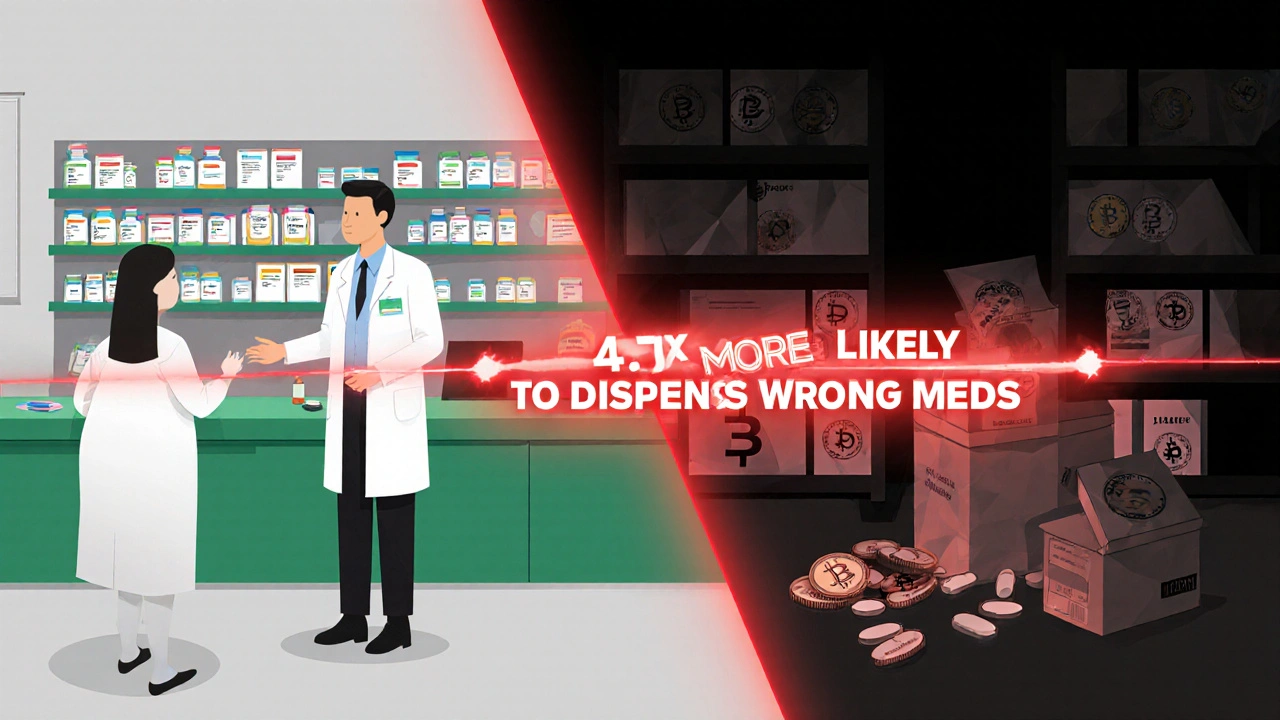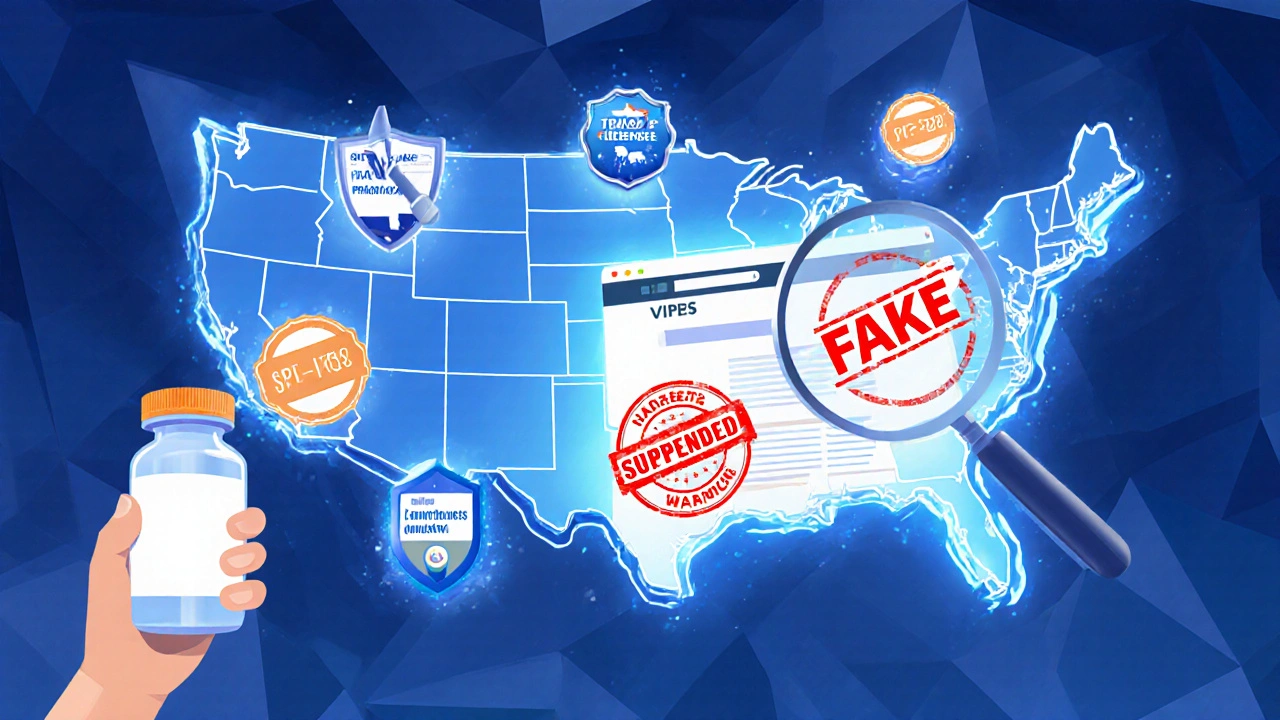Every year, millions of people buy medications online without checking if the pharmacy is real. That’s dangerous. Counterfeit drugs are flooding the market-pills with no active ingredient, wrong doses, or even toxic chemicals. The FDA estimates that 1% to 3% of the $575 billion U.S. prescription drug market comes from unlicensed sources. That’s between $5.75 billion and $17.25 billion in fake or unsafe medicine. You don’t need to be a pharmacist to protect yourself. You just need to know how to verify a pharmacy is licensed and legitimate.
What Makes a Pharmacy Licensed?
A licensed pharmacy isn’t just a website with a nice logo and a fake seal. It’s a business that has gone through strict government checks. Each state in the U.S. has its own Board of Pharmacy that issues licenses. These boards make sure the pharmacy follows safety rules, hires qualified pharmacists, and keeps accurate records. Without a license, a pharmacy is breaking the law-and you’re at risk.Every licensed pharmacy must have at least one pharmacist-in-charge who passed the North American Pharmacist Licensure Examination (NAPLEX). That’s a tough test. You need a score of at least 75 out of 150. Many states also require a second exam on local pharmacy laws. In California, it’s called the CPJE. These aren’t just paperwork steps. They’re designed to stop people who don’t know what they’re doing from handing out pills.
Legitimate pharmacies also have a physical address you can visit. They don’t just ship from a PO box. They have a real building with proper storage for medications-coolers for insulin, secure cabinets for opioids, and systems to track every pill from the supplier to your hand. If a pharmacy won’t show you its physical location on Google Maps, walk away.
How to Check If a Pharmacy Is Licensed
You don’t need to call a government office or wait weeks. You can check a pharmacy’s license in under five minutes. Here’s how:- Go to your state’s Board of Pharmacy website. Every state has one. For example, if you live in Texas, go to the Texas State Board of Pharmacy. If you’re in Florida, use the Florida Department of Health’s license lookup. These sites are free and updated daily.
- Search by pharmacy name or license number. Don’t use the full address or website URL. Just type in the exact name of the pharmacy as it appears on their site. Some states, like California, tell you to enter the license number without the prefix (like "P-" or "Pharm"). If you’re not sure, look at their printed license-usually posted in the store or on their website.
- Check the license status. Look for words like “Active,” “In Good Standing,” or “Current.” If it says “Inactive,” “Suspended,” or “Revoked,” that pharmacy is not allowed to operate. Don’t ignore this.
- Look for disciplinary history. If the pharmacy or pharmacist has been fined, warned, or punished before, it will show up here. One warning might not be a deal-breaker. Multiple violations? Walk away.
For pharmacies that ship across state lines, use the NABP Verify tool. It checks licenses across 43 states in real time. It’s not free-it costs $125 a year for professionals-but consumers can search for free. Just go to www.nabp.pharmacy and click “Verify a Pharmacy.”
Red Flags That a Pharmacy Is Fake
Counterfeit pharmacies are getting smarter. They copy real websites. They use fake reviews. They even create seals that look like NABP’s VIPPS logo. But they can’t hide everything. Here are the top five red flags:- No prescription required. Legitimate pharmacies in the U.S. require a valid prescription for controlled substances and most prescription drugs. If a site lets you buy Viagra or Adderall with no doctor’s note, it’s illegal.
- No pharmacist available to talk to. A real pharmacy has a pharmacist on staff you can call or chat with. You should be able to ask about side effects, interactions, or how to take your medication. If there’s no phone number, no email, and no live chat with a licensed person-run.
- Prices that seem too good to be true. If a $300 insulin pen is being sold for $40, it’s not a deal. It’s a trap. Legitimate pharmacies don’t undercut prices that low because they pay for licensing, storage, insurance, and staff.
- No physical address or vague location. If the address is just “123 Business Center, Suite 100” with no street name or city, or if Google Maps shows an empty warehouse or a residential house-that’s not a pharmacy.
- Payment only by wire transfer or cryptocurrency. Legit pharmacies accept credit cards, insurance, or PayPal. If they only take Bitcoin or Western Union, they’re trying to disappear after you pay.

What Is VIPPS and Why Does It Matter?
The Verified Internet Pharmacy Practice Sites (VIPPS) program is run by the NABP. It’s the gold standard for online pharmacies. To earn VIPPS accreditation, a pharmacy must:- Be licensed in every state it ships to
- Have a licensed pharmacist on duty 24/7
- Require valid prescriptions
- Provide clear pricing and contact info
- Pass an on-site inspection
Only about 1,800 pharmacies in the U.S. have VIPPS status. That’s less than 3% of all pharmacies. But if you’re buying online, it’s the single best way to know you’re safe. Look for the VIPPS seal on the website. Then, click it. It should link directly to the NABP’s verification page showing the pharmacy’s active status. If the link goes to a random site or doesn’t work, the seal is fake.
Don’t trust third-party review sites like Trustpilot or Better Business Bureau alone. In 2023, the BBB reported a case where a consumer lost $850 to a fake pharmacy that displayed a forged VIPPS seal. Always verify through official channels.
What Happens If You Buy From an Unlicensed Pharmacy?
It’s not just about wasting money. Fake drugs can kill.In 2022, the NABP found that unlicensed pharmacies were 4.7 times more likely to dispense the wrong medication and 8.2 times more likely to be involved in diverting controlled substances like oxycodone or fentanyl. Some counterfeit pills contain fentanyl-deadly even in tiny doses. Others have no active ingredient at all. People with diabetes who took fake insulin have gone into diabetic ketoacidosis. People with high blood pressure who took fake pills ended up in the ER.
And there’s no recourse. If you buy from a fake pharmacy, you can’t file an insurance claim. You can’t get a refund. You can’t even report it to the FDA easily because the pharmacy is often based overseas and uses fake names.
Real cases are happening. In March 2024, a woman in California discovered her pharmacy’s pharmacist-in-charge had resigned without notifying the state. The license was still active, but no licensed pharmacist was on duty. She caught it because she checked the state board’s website. She switched pharmacies. She avoided a potential disaster.
What’s Changing in 2025?
Regulators are catching up. In January 2024, California started requiring out-of-state pharmacies shipping to residents to provide an 800-number for direct pharmacist access. The FDA has launched a $15 million initiative to detect fake online pharmacies, aiming for a 40% drop in consumer harm by 2026.NABP’s InterConnect system now gives real-time license updates across 43 states. More states are moving away from paper checks and toward automated systems. By 2027, experts predict national licensure standards will cut verification complexity by 60%.
But the biggest change? Consumers are waking up. A 2023 University of Florida study found that 92% of people who tried to verify a pharmacy succeeded in under five minutes. The problem isn’t difficulty-it’s awareness.
What to Do Next
If you’ve ever bought medicine online-or are thinking about it-do this now:- Write down the name of your pharmacy.
- Go to your state’s Board of Pharmacy website.
- Search for the license. Check the status.
- If it’s online, look for the VIPPS seal and click it.
- If anything feels off, call your doctor and ask for a referral to a licensed pharmacy.
You don’t need to be an expert. You just need to be careful. A few minutes of checking can save your life-or the life of someone you love.
How do I know if a pharmacy website is real?
Look for three things: a physical address you can verify on Google Maps, a licensed pharmacist you can contact, and a valid state license you can check on your state’s Board of Pharmacy website. If the site doesn’t require a prescription for controlled drugs, avoid it. Also, click any accreditation seals like VIPPS-they should link directly to the NABP’s official verification page.
Can I trust pharmacies that offer free shipping or huge discounts?
No. Legitimate pharmacies don’t offer deep discounts on brand-name prescription drugs because their pricing is regulated by insurance and pharmacy benefit managers. If a pharmacy sells insulin for $20 when it normally costs $300, it’s likely counterfeit. Free shipping is a common tactic used by illegal pharmacies to lure customers. Always verify the license first.
What’s the difference between a licensed pharmacy and a VIPPS pharmacy?
All VIPPS pharmacies are licensed, but not all licensed pharmacies have VIPPS status. VIPPS is an extra certification for online pharmacies that meets stricter safety standards, including 24/7 pharmacist availability and on-site inspections. If you’re buying medicine online, VIPPS is the gold standard. For local, in-person pharmacies, state licensure is enough.
Why can’t I just trust a pharmacy with good reviews?
Fake pharmacies often pay for fake reviews. Trustpilot, Google Reviews, and even Better Business Bureau ratings can be manipulated. A pharmacy with 4.8 stars can still be selling counterfeit drugs. Always verify through official government sources like your state’s Board of Pharmacy or NABP Verify-never rely on reviews alone.
What should I do if I already bought medicine from a suspicious pharmacy?
Stop taking the medication immediately. Contact your doctor and tell them what you took. Report the pharmacy to the FDA through their MedWatch program at fda.gov/medwatch. Also, file a complaint with the FTC at reportfraud.ftc.gov. Keep the packaging and receipts. Even if the medicine seems fine, it could be contaminated or expired.


james lucas
man i just checked my govt pharmacy and it was active lol i thought they all just took your money and shipped magic pills from india. glad i didnt just trust the 99 cent insulin deal on facebook. also why do they always use the word 'verify' like its a crypto wallet lmao